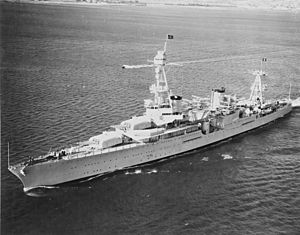USS Macon (ZRS-5) facts for kids
Quick facts for kids USS Macon (ZRS-5) |
|
|---|---|
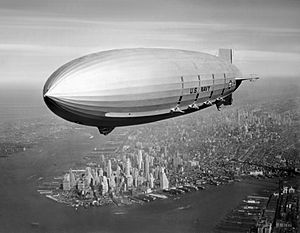 |
|
| USS Macon over New York City in 1933 | |
| Career | |
| Manufacturer | Goodyear-Zeppelin Corporation, (Springfield, Ohio) |
| Manufactured | 31 October 1929 (Commenced) 8 August 1931 (Launched) |
| Serial | ZRS-5 |
| First flight | 21 April 1933 |
| Owners and operators | United States Navy |
| In service | 23 June 1933 (Commissioned) |
| Last flight | 12 February 1935 |
| Aircraft carried | 5 x Curtiss F9C 'Sparrowhawk', Consolidated N2Y-1, Waco XJW-1 |
| Fate | Crashed off the coast of California, 12 February 1935 |
| General characteristics (as built) | |
| Class and type | Akron-class airship |
| Displacement | 7,401,260 cu ft (209,580.3 m3) |
| Length | 785 ft (239.3 m) |
| Beam | 133 ft (40.5 m) (hull diameter) |
| Draft | 146 ft 5 in (44.6 m) (height) |
| Installed power | 560hp per engine |
| Propulsion |
|
| Speed | |
| Range | 5,940 nmi (11,000 km; 6,840 mi) at 10 knots (19 km/h; 12 mph) |
| Complement | 60 |
| Armament | 8× .30-cal machine guns |
| Aircraft carried | 5 Curtiss F9C Sparrowhawk |
| Aviation facilities | 1 aircraft launch trapeze |
The USS Macon (ZRS-5) was a huge airship built for the United States Navy. It was like a giant flying ship designed to carry smaller airplanes. These smaller planes, called parasite aircraft, could fly off the Macon and then return to it. The Macon could carry five single-seat Curtiss F9C Sparrowhawk planes for scouting or two-seat planes for training.
The Macon was in service for less than two years. In 1935, it crashed in a storm off the coast of California. Most of its crew were saved. Today, the remains of the Macon are listed as a historic site in the U.S. National Register of Historic Places.
The Macon and its "sister ship" the USS Akron were among the largest flying objects in the world. They were almost as long as the famous Hindenburg. The Macon and Akron were filled with helium, a safe gas. They still hold the world record for the largest helium-filled airships ever built.
Contents
Building the Macon
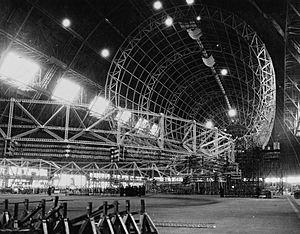
The USS Macon was built in Springfield Township, Ohio. It was made by the Goodyear-Zeppelin Corporation. This was the biggest airship ever built in America. A team of skilled German engineers helped design and build both the Akron and the Macon.
The Macon had a strong metal frame made of duralumin. It stayed in the air thanks to 12 large bags filled with helium gas. These bags were inside the ship's frame. The airship had eight powerful Maybach VL II engines. These engines used gasoline and had 12 cylinders, each producing 560 horsepower.
The engines powered propellers that could turn to help control the ship. This was an early way to direct the ship's movement during takeoff and landing. The Macon also had a special system to collect water vapor from the engine exhaust. This water was used as weight to balance the ship as fuel was used up.
Service History
First Flights and Naming
The Macon was officially named on March 11, 1933. It was named by Jeanette Whitton Moffett, whose husband was Rear Admiral William A. Moffett. He was in charge of the U.S. Navy's airship program. The airship was named after the city of Macon, Georgia. This city was in the area represented by Carl Vinson, a powerful member of the U.S. House of Representatives.
The Macon flew for the first time on April 21, 1933. It stayed in the air for almost 13 hours with 105 people on board. This happened shortly after its sister ship, the Akron, crashed. The Macon officially joined the U.S. Navy on June 23, 1933. Commander Alger H. Dresel was its first captain.
Early Operations
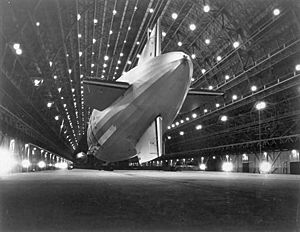
On June 24, 1933, the Macon flew to Naval Air Station (NAS) Lakehurst, New Jersey. It spent the summer there, doing many training flights.
The Macon had a more successful time than the Akron. Its commanders learned how to use the airship's planes for scouting. They would keep the Macon hidden while its smaller planes searched for things. The Macon took part in several Navy exercises. The small planes, called Sparrowhawks, would have their landing gear removed while on the airship. This allowed them to carry more fuel and fly farther.
- Some design details
The Macon first launched and retrieved its planes on July 6, 1933. The planes were stored inside the airship. They used a special "trapeze" system to launch and catch them.
On October 12, 1933, the airship flew across the country. It went to its new home base at NAS Sunnyvale (now Moffett Federal Airfield) in California.
1934 Activities
In 1934, two two-seat Waco UBF XJW-1 biplanes were given to the USS Macon. These planes also had special hooks to attach to the airship.
In June 1934, Lieutenant Commander Herbert V. Wiley became the captain of the Macon. He surprised President Roosevelt and the Navy. The Macon found and tracked the cruiser Houston. The President was on this ship, returning from Hawaii. The Macon even dropped newspapers to the President's ship! President Roosevelt sent a message praising the Macon for its great work. Wiley was later promoted to commander.
The Loss of the Macon
Before the Crash
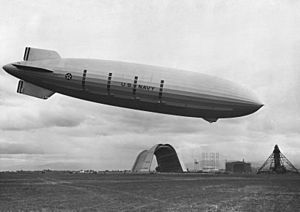
On April 20, 1934, the Macon flew from California to Florida. This was a difficult flight. The airship had to fly very high over mountains. In the hot Texas weather, the helium inside expanded. The extra gas had to be released.
During the flight, a strong gust of wind caused damage to the Macon's frame. Two important metal beams broke near the tail fin. The crew quickly repaired the damage. The Macon finished its journey safely. More permanent repairs were made in Florida. However, some extra metal supports for the tail fin were not finished. The Navy decided it was not necessary to keep the Macon grounded until these were done.
The Crash
On February 12, 1935, the Macon was returning to California from Navy exercises. It flew into a bad storm off Point Sur. The storm caused a sudden change in wind direction, called a wind shear. This caused the unfinished part of the frame to break. The upper tail fin broke off. Pieces of the broken structure poked holes in the helium gas cells. Helium began to leak out.
The captain, Commander Wiley, quickly ordered the crew to drop ballast (weight). But the ship lost control. It became tail-heavy and rose very high, much higher than it should have. It kept rising until enough helium escaped to make it lose lift. The Macon slowly descended into the ocean.
It took 20 minutes for the airship to sink gently into the sea off Monterey Bay. Only two crew members were lost. This was because the water was warm, and the Navy had added life jackets and rafts after the Akron disaster. One crew member jumped too early and did not survive. Another drowned trying to get his belongings. Commander Wiley saved an officer by swimming to help him.
Sixty-four survivors were picked up by the cruiser Richmond. Other cruisers, the Concord and the Cincinnati, rescued more survivors.
A sailor named Dorsey A. Pulliam saw the crash from another ship. He wrote in a letter that the Macon came out in the storm and never got back to land. He said the crew abandoned the ship as soon as it hit the water. He also mentioned that the gas caught fire and burned on the water's surface after the wreckage sank.
The Macon had completed 50 flights. It was removed from the Navy's list of ships on February 26, 1935. After this, the Navy decided to use only smaller, non-rigid airships called blimps.
Exploring the Wreck Site
In February 1991, the Monterey Bay Aquarium Research Institute (MBARI) found the wreckage of the Macon. They used sonar, video, and cameras to study the site. They also brought up some pieces from the wreck.
In May 2005, MBARI returned to the site. They used special sonar to map the area.
2006 Expedition
In September 2006, a more detailed exploration took place. Researchers from MBARI, Stanford University, and NOAA used remotely operated vehicles (ROVs). Videos of this trip were shared with the public.
The 2006 trip was very successful. It showed new things and changes since the last visit 15 years before. They took high-quality videos and over 10,000 new pictures. These pictures were put together to create a detailed map of the wreck.
Protecting the Site
|
U.S.S. Macon Airship Remains
|
|
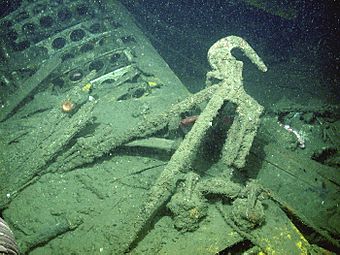
A "sky hook" on the remains of one of Macon's F9C-2 biplanes (2006).
|
|
| Location | Monterey Bay National Marine Sanctuary, Big Sur, California |
|---|---|
| Area | 5654.7 square meters |
| NRHP reference No. | 09001274 |
| Added to NRHP | 29 January 2010 |
The exact location of the wreck is kept secret. It is located deep within the Monterey Bay National Marine Sanctuary. Divers cannot reach it because it is about 1,500 ft or 460 m deep.
The U.S. National Park Service says that the USS Macon was the most advanced airship of its time. It showed the best of naval airship technology. The Macon was 785 feet long. Its size amazed Americans as it flew over cities. The loss of the Macon and its sister ship Akron led the Navy to stop its large airship program. The remains of the Macon are now off California's Big Sur coast. The site also holds the remains of four of its small F9C Sparrowhawk scout planes.
The site was added to the U.S. National Register of Historic Places on January 29, 2010.
See also
 In Spanish: USS Macon (ZRS-5) para niños
In Spanish: USS Macon (ZRS-5) para niños






